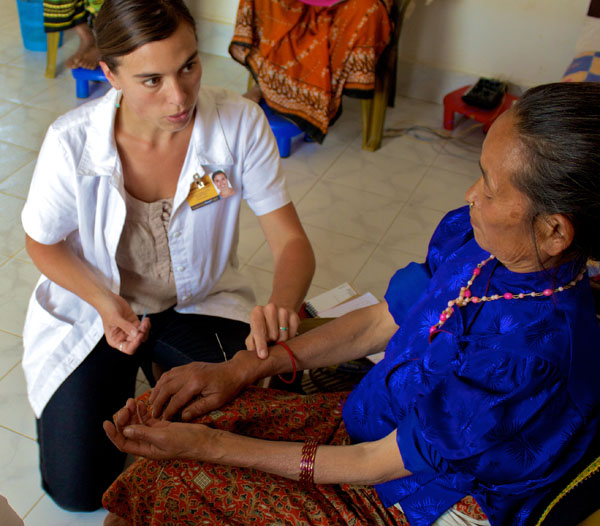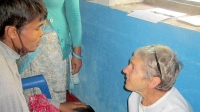
There are three women around the ages of 30, 50, and 65, who have come to see me for treatment several times. They arrive in a big group from their village, and emanate strength, solidarity and patience as they sit and wait readily in my clinic room, wearing bright saris wrapped well under patterned long sleeved frocks, with bustle-like mounds of cloth bundled up around their navels. A cascade of earrings, necklaces and nose rings of red and gold tell the stories of their marriages, while their sun worn faces, dirt caked feet and full black eyes tell the stories of their work.
In our research efforts we ask our patients their age, their primary language, and their distance of travel to get to the clinic. These three are Tamang, and walk over 4 hours to get to the clinic, where they then wait in line for treatment for another 4 hours with the crowd. When their turn comes around, they bring their hands together in the blessing of thanks, hello, goodbye: “namaste”, or, “I see the god within you”, and then they quietly point to their joints and limbs saying, “duksa” – “pain.” Although they each have a different story, they have common underlying health concerns. Their bodies hurt. They all have shoulder pain radiating down one arm. They have bad headaches wrapping across the front of their heads to the back of the neck. Their knees ache. I inquire about their work and home life to discover the cause of their pain, and an interpreter relays their collective story to me.
It is corn harvest now, soon followed by rice harvest, so the days will be long for some time. The day begins before dawn, at 4am in the fields, where they work until the late afternoon. They gather their harvest into giant baskets and sacks as heavy as themselves, and haul them back home by strapping the load across their brow, bearing the weight on their heads, necks and backs. When they return to their homes they go to the village wells and fill heavy copper water vessels, carried under one arm back to their kitchens. Then they feed and water the buffalo, goats, cows, and chickens, cook for their families, take care of the children and the old ones, nurse the sick and finally eat their dinners. They hang the ears of corn to dry in in their windows, hung from beams, or in bound up towers that look like trees. In the night they separate the corn kernels from the ears that have already dried. They leave it in mounds on the rooftops or the dirt streets until daylight, when they can spread it out flat to dry a second round in the sun. They work from 4am until midnight, resting only briefly before the next day of harvest begins again.
 As I treat the pain from the brunt of this work, I am able to connect with each of them, learning more about their stories and perpectives on the world.
As I treat the pain from the brunt of this work, I am able to connect with each of them, learning more about their stories and perpectives on the world.
The middle of the three has asthma. When she walks up the hill carrying grasses and corn on her back, or when she bends down to clean the cow dung, from the floor she feels breathless, as if rice husks are blocking her chest and throat.
The oldest of the three sleeps only 3 hours a night because there is too much work to get done. She shows me bruise-like spots on her legs and arms where demons had punished her by biting her and sucking her blood.
The youngest one has pain in her uterus from several miscarriages, and is afraid that her family will be angry with her if she does not produce a baby soon.
I work with each of them to address their concerns, and feel grateful for the stories that they share with me in the process.
These women inspire me. They walk long distances, have strong spirits, and don’t complain. They teach me about strength and patience, and seem almost mythical in their capacity for life’s work. They well may be the hardest workers in the world. Their solidarity creates a force that is bigger than themselves, an arc of connection, fellowship, and fortitude that they lift from the feet of their ancestors, and pass on to their daughters and grandchildren. They give birth and sustain life through their labor, dedication and community, and they bear the weight of their harvested nourishment on their backs.
One of the other women waiting for treatment in the room asked out to the group and to me, “Why is it that women have so much pain?”
The answer beheld itself. ---Danielle Lombardi











